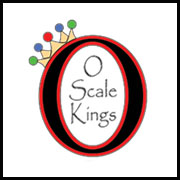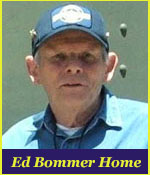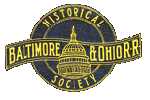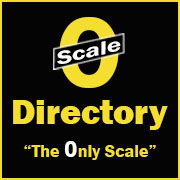Ed Bommer
Upgrading a Westside B&O P-7c to B&O 5314 as a P-7e
By Edward F. Bommer
The Westside Model Company announced its imported brass O scale B&O “President Class” P-7 4-6-2 from Sam-Hong-Sa in 1979. The P-7 modeled the first of the class number 5300, ”George Washington.” The second was a modernized P-7c with a set of six Boxpok drivers modeling the 5314, which had been "President Lincoln". The P-7 class lost their names after Roy B. White became president of the B&O about 1940.
These were very well made models with excellent detail, even though they did contain some detailing errors. I purchased a Westside B&O P-7c at an Oklahoma City train show in 2003. It was still unpainted and appeared to be in good condition. However, when placing it on track to run, the wheels barely stood on the rails. Their gauging was narrower than NMRA standard as was the profiles of the wheel treads. It was not P-48 either, as that was not known in 1979. For the next 3 years it remained in its Westside box. I later learned that it had been built to PSC Gauge, outlined in Precision Scale’s steam locomotive parts catalog.
From a few other people I know in O scale, they too came across Westside locos that could not run on curves or through switches because of that odd gauging. I suppose these became expensive shelf queens. Below is my Westside. The drivers are fully on the rails to the right, but only about 1/64” of the tread stands on the left rail.
Re-gauging the tender wheels as well as the pilot and engine truck wheels was a cinch. The drivers were quite difficult since changing their gauge also meant changing the valve gear and crosshead hangers so the rods would not bind. Widening the driver gauge also induced more lateral play in the drivers on their bearings.
I solved this by making smooth, thin, polyethylene inserts from plastic can lids. A hole for the axle was cut into discs serving as thrust washers. A cut as made so it could slip over the axle while in place on the frame. I allowed a bit more play for the center driver to ease the loco on curves. To keep the rods from binding on the valve gear and cross head hangers were widened by re-soldering their end fittings by moving them out ward about 3/64” on each side.
This allowed the same mounting holes and screws to be used in re-assembly. Bench test running was done on a set of rollers to assure there was no binding or possible rod striking of any details.
Test running the re-gauged Westside P-7c on a large layout in Sherman TX in 2007.
In 2007, the gauged Westside P-7c rolls a passenger train along my Baltimore & New York layout which was under construction at the time.
Next was the problem of the rear or engine truck wheels did not turn freely. To solve that issue the truck was completely disassembled. The castings had to be adjusted to match each other by bending here and there as the truck had been damaged. Westside had included roller bearing journals, whereas the 5314, according to the B&O diagram below, was equipped with plain bearings. Changing them and making notes on what other details needed to be changed or secured for the 5314 was made and an order sent to Precision Scale.
This diagram for B&O Class P-7e (sorry my scanner cut off the class designation as the page was too long), shows a smooth pilot and running board skirting which was applied to only one or two of the class. B&O converted six P-7 locos to this plan in 1949: Numbers 5312, 5314, 5315, 5316, 5317and 5319. They were intended to be substitutes for diesel electric power on B&O passenger trains between Jersey City and Washington DC. The larger tenders would allow for a full run with no stops coal or water. However, they instead worked out their lives between Cincinnati, Detroit and Wheeling WV until retirement in 1957.
B&O 5314 was also unique in having a front end throttle. So adding parts for this was also on the list of re-detailing work to be done.
The running gear of B&O 5314 in 1956 gets a boiling water and kerosene hose-down at Wheeling WV before being re-lubed and made ready for another run. The exposed working machinery of a steam locomotive was kept clean as possible as dirt was the enemy, causing excessive wear of the parts.
Below, the right side of B&O 5314, just out-shopped at Mount Clare in 1949. The Westside will be re-detailed to model this locomotive.
The front end will need the most work. Visors on the headlights were removed by 1946. Also the Worthington feed water heater and stack sit far too high at a scale 17’! That’s taller than a UP Big Boy 4-8-8-4! The reason why is because the smoke box is jacketed on a P-7e boiler. The jacket thickness was about 6”- 8”. Cutting the stack down was easy. Thinning the cast brass Worthington feed water heater unit with grinding bits was much more tedious and tricky. Any other detail items with loose or failing solder joints had to be removed and replaced as well.
To have this loco become a P-7e of 1949, a new tender would be needed. Sunset 3rd Rail had produced that tender with its B&O T-3 4-8-2 project that offered the option of a 12wheel all welded tender or the lengthened Vanderbilt tender. So I was able to purchase one of the big 12 wheel welded tenders for my Westside loco. The Westside P-7c tender had a significant number of faults, two of which would be difficulty to correct.
The top of the coal bunker should be curved, to well match the cab roof line. On the Westside it is nearly straight up. To fix this, the forward and rear coal bunker ends need to be re-cut to a more pronounced curve. To do that the sides need to be removed from the body and re-bent at the top to match the new curve. With that the beading on the top edge would need to be replaced as well. Also underneath the tender there should be a water scoop. These locos could pick up water “on the fly” from track pans in New Jersey, Pennsylvania and Maryland on their runs between Jersey City and Washington DC, the mainline where P-7 class locos were assigned.
The next fix required would be to lower the rear deck of the Westside tender, as it is up, at the top edge of the sides. Below is how the tender deck for a P-7c should be. It is below the top edge of the tender which has had its coal bunker enlarged. With that, B&O also ran a heightened sides around the water tank which was not enlarged, because of having water scoops and track pans. To lower the deck on the Westside, the body sides would be taken off, the deck made longer, as it would run farther forward, the water tank lid would need to have an extension made as seen here as well as the end ladder and steps to the coal bunker put in. Then the whole tender must be re-assembled, likely best done also to re-curve the top of the coal bunker sides as well.
Those would be too many steps and going too far for me. So I opted to make my Westside P-7c into a P-7e with a Sunset 3rd Rail tender, which only needed a paint job after revising its front deck to match the P-7 cab floor.
Paint and re-detailing went hand in hand. Here the smokebox front was given a dual beam headlight, clear class lamps, and ahead light conduit along with paint and the loco number.
Likewise, the front end was fitted with an etched B&O Capitol Dome of the correct size, replacing a somewhat smaller cloisonné emblem from Westside. Scale Coat B&O Royal Blue paint was used. Floquil’s Santa Fe mineral brown is on the coupler.
The boiler was detailed with a front end throttle along with an access hatch. The stack and feed water heater have been lowered. Westside had included a number of .015”diameter wires on the boiler as conduits, which were removed as being extraneous.
The cab details were also revised, replacing the original throttle with a headend throttle as relocating gauges to suit. B&O painting specs call out green walls and ceilings for steam loco cabs, with the back head being the locomotive color – in this case, BandO Blue. Weathered black, graphite and dull silver variously applied and dry brushed complete the finish.
The cab interior walls and ceiling are green, as specified by B&O BandO Blue (Scale Co B&O Royal Blue) for the exterior. A specially made B&O steam loco decal set was used for lettering, which include the SAVE COAL admonishments – important in the late 1940s with John L. Lewis leading a nation-wide coal miner’s strike. Window glazing had not yet been installed in this shot.
Above, the front end is mounted on the frame, which was painted flat black. I also added brake cylinders for the drivers, seen to the right of the steam chest.
The tail piece of the frame was panted BandO Blue, as well as the drivers, engine truck frame and its wheelset. PSC stoker casting was modified to fit and installed on the top of the tail beam, filling otherwise empty space under the cab.
So there we have it, five subassemblies detailed and painted, ready to be assembled into a model of B&O 5314.
Two views of the completed B&O P
-7e.
In the meantime, Sunset 3rd Rail imported their excellent brass models specifically detailed for B&O 5314 as well as the 5315 as seen above, for both of which I had provided some assistance.



